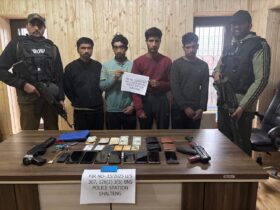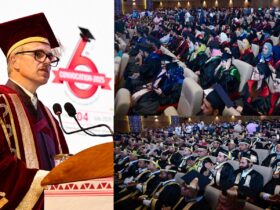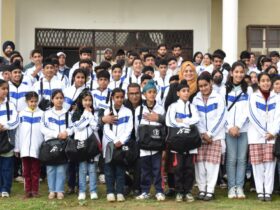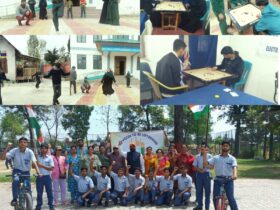Malik Sajid
Former Agriculture Minister G. H. Mir, his Deputy Nazir Ahmad Khan Gurezi and few officers of his department had an overseas study tour to Spain during December, 2013 to learn the best technology for Saffron cultivation. The minister in a statement released from Albacete city of Spain had said that he discussed Saffron Mission with Spain Scientists and that all factors needed for revival of State’s world famous Kashmiri Saffron have been addressed adequately under National Mission on Saffron Project. He had also expressed optimism that within the next two years the scenario in terms of production and productivity as also the quality of saffron will totally change in a positive direction. In his statement he went on saying that the two important components required for production and productivity viz re-planting of corms on scientific lines and creating irrigation facilities have started yielding results-a statement which was far from truth because the irrigation facility was not at all started then. The delegation led by Mir, after having an interactive meeting with the members of Valeriono Gonzalez Foundation and farmers of Spain, had visited some Saffron fields in Albacete, where they (delegation) had observed that corm density and irrigation has given good results in Spain, added the report.
However, analysing various documented reports on the subject of Saffron Mission, it can be concluded that on ground there have been problems in implementation of these important components of the mission. Non-availability of corms of standard size has been a major impediment in implementation of the mission as corms of standard size are not sufficiently available to meet the required corm density. The sprinkler irrigation component is yet to take off. Even saffron growers say that multi-million dollar Saffron Mission, launched in 2010 to revive saffron cultivation by helping counter erratic rainfall, is yet to ensure the most basic requirement of irrigation for their crop. Putting in place sprinkler irrigation in saffron fields was a key objective of National Mission on Saffron. Saffron growers have been complaining for years that a lack of rainfall at crucial times has led to a decline in production – and things are getting worse. One or two spells of rain in September and October are vital for the crop to flower. But in most of the recent years it either hasn’t rained in those months or has rained too much, thereby affecting saffron production drastically. In Lethpora-Pulwama, where most saffron production is concentrated, farmers said their concerns about irrigation are yet to be addressed. The most important thing the government was supposed to do for us was to make water available for our crop,” said a farmer.
Quoting Mission Director of National Mission for Saffron Altaf Aijaz Andrabi, an online news portal in its article titled, “Kashmir Saffron plan failing to revive crop, says water starved farmers” reported that the department had dug 103 tube-wells of the required 128, but pipes are yet to reach the fields as local construction firms with “nefarious designs” had prevented the Mechanical Engineering Department (MED) from expanding the pipe network. “There is a land mafia in the area which wants to convert the saffron land into residential colonies and commercial establishments,” he had said, adding that the mafia feels if irrigation facilities are put in place for saffron cultivation, it will further motivate the growers to pursue saffron farming – so they create hurdles. But farmers, expressing doubt on alleged actions of a few developers to affect the entire saffron-growing region, questioned this explanation, arguing the government was using it as a pretext for not providing the promised irrigation, reported the online news portal, adding, the reality is that government has failed to create even a single sprinkler irrigation facility in five and a half years.
The reported decline in saffron production had also come up for discussions in a meeting of high level officers held under the chairmanship State’s Chief Secretary in which Agriculture Department had been asked to identify the bottlenecks responsible for the reported decline in Saffron production over past one decade. Besides, in the meeting, the department had been advised to take immediate pro-active steps to ensure provision of irrigation facilities to the saffron crop as production loss is being attributed to the lack of irrigation.
This year, the present Minister for Agriculture Gh. Nabi Lone Hanjura along with some officers is scheduled to visit Spain during the middle of October. But most people here including detractors and more importantly the tax payers would want to know- a) How earlier Spain tour has benefitted the saffron growers? b) What had they learned in Spain during their 2013 tour and what had been its impact on Saffron production and quality in Kashmir? and c) What remained unlearned that the current team is going to learn?
The foreign tours must be clearly focussed on what the country wants to achieve. The overseas travel policy of Government of India stresses on ensuring tangible benefits to the state in utilising public funds to finance such overseas travels. The policy envisages that every effort shall be made to minimise the cost of official overseas travel. Hence, all forms of communication, for example, teleconferencing and videoconferencing, must be explored as an alternative to overseas travel in order to minimise costs.
Pertinently, Mrs. Maneka Gandhi, Union Minister for Women and Child Development then in opposition Hon’ble Member of Parliament had openly criticised the Saffron Mission in an article titled Mission Saffron: Failed Bureaucratic Committees published in daily Greater Kashmir on July 26, 2012. She had questioned that where will the Rs. 372 crores go? Probably to building a huge Saffron Bhavan (as a memorial !) and to meetings across India – and of course, delegations of bureaucrats to Spain to see how they grow saffron there


















Leave a Reply